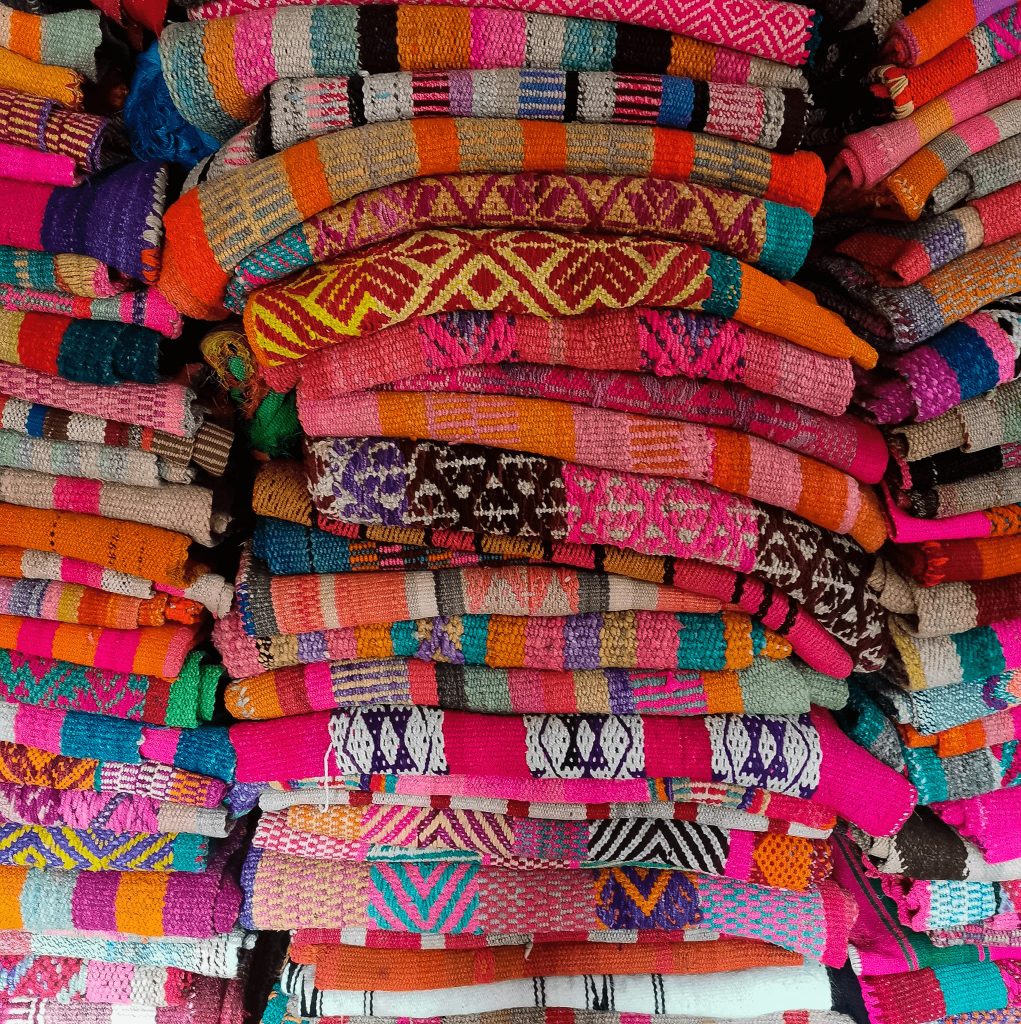Peru is an ancient country, filled with tradition and culture. Among the layers of history recorded in the Inca’s old nation, one remains alive today. Some people continue to practice these Peruvian traditions and customs by following in their ancestors’ footsteps. That’s why we’d like to bring up the famous Peruvian textiles.
From unique weaving techniques, exquisite natural dyes, and intricate designs, Peruvian textile is a tradition that fortunately is still alive and still passes over generations. In this post, we’ll see how important textiles are in Peruvian Culture.
Textiles in Pre-Inca Cultures
The earliest textiles discovered in South America come from Peru and date back more than 10,000 years. Peru was home to several pre-Incan cultures. These included the Chavin, Mochica, Wari, Paracas, and Nazca cultures.
Paracas Culture’s fine textiles date to 650 B.C., and they used them to wrap their dead for religious rites. The dead became mummies thanks to the embalming process. Later, people called these wrappings “Fardos Funerarios” (Paracas mummy bundles). The mummies and the textiles around them were kept in good condition because they were buried underground, despite the fact they date back more than 2000 years ago.
Even though the backstrap loom was invented in Asia, the Chavin Culture pioneered it in South America. They did so as they developed many weaving techniques. Decorated plain-woven cotton strands represent the Chavin style’s origins. The elaborate textiles proved their extensive production for ceremonies and worship.
The Nazca people created beautiful and intricate embroidery and tapestries. The harsh desert forced people to keep their valuable creations in underground tombs. The tombs give us many clues about their way of life since they lacked written records.
Mochica Culture is known for the quality of their high-relief pottery, however, their textiles offer quality bags and robes. Wari Culture employed a technique contrasting colored threads on fabric to produce both positive and negative designs. Wari weavers employed this method to create elaborately decorated mantles, belts, and bags.
Textiles in the Inca Period
The Incas inherited a substantial and long-standing textile legacy. They dyed camelid fiber such as vicuna, llama, or alpaca, and wove it into patterns and shapes. These designs are used to represent the weaver’s house and family, as well as their social order in the empire. Incas used to worship Mother Earth, the “Pachamama” (Mother Earth), the Sun god, animals, etc, so they expressed that fervor in their fabrics, which honored them.
Their creations capture vibrant colors, including red, purple, orange, blue, yellow, cyan, and green. The Inca people got the colors’ natural dye from plants, minerals, and insects, and used it for thousands of years. One of the insects was the cochineal, a tiny, cactus-dwelling bug.
The Incas valued their textiles, that’s why they set up huge textile factories across the empire. They hired skilled men and women to make lots of textiles. Weaving was not simple, it required a great level of talent and effort. The Inca weavers used a backstrap loom, a weaving item that their predecessors used in their fabrics. This made weaving an integral part of daily life.
Another reason the Incas treasured their textiles is that they used it as a way of communication. The Incas captured stories, tales, and traditions in the threads of their creations. They passed them down from generation to generation, keeping their ancient legacy alive.
The Inca textiles reflected the garment owner’s social rank, as the royalty wore more elaborate garments. The wearer’s status increased as the pattern became more complicated. However, they also showed their skill. Their textiles were seen, in some cases, as more valuable than gold or silver.
The Incan Empire textiles were more than an art form. They were also a way of expressing beliefs. For example, the red color represents earth or power, the green crops, and black the underworld.
Their geometric patterns, designs, and motifs represented deities and natural elements. Animals such as the condor, puma, and snake are often depicted. They have a strong connection with the Inca-Andean anthology vision. The Incas believed in three realms, or “pachas” in the Quechua ancient language. These were: The Gods’ Kingdom (Hanan Pacha), the living beings’ kingdom (Kay Pacha), and the underworld (Uku Pacha), or Inca hell. That was deep considering our topic here’s textiles!
The Colonial Period & Present
By the XVI century, the Spaniards imposed their traditions, culture, and religion on Peru’s indigenous peoples. They introduced new materials such as silk, sheep wool, and new techniques. This was the period where traditional textile production suffered as the Spaniards were tough on them as they did not want any competition.
Spaniards banned indigenous people’s art as they enslaved and forced Peru’s indigenous people to design and make European fabrics and textiles. The establishments where these people used to perform this forced labor were called “Obrajes”
In these places, the Spaniards ordered people to make low-quality, inefficient textiles. Thus, the quality of Inca textiles decreased. Spanish tried to eliminate Inca textiles.
However, indigenous weavers kept making traditional clothes in secret using superb alpaca and vicuna fiber. They also used exotic components like silk or wool. Throughout the colonial period, Inca and Andean weaving became tied to indigenous resistance.
The history of Peruvian textiles continued. Its art remains a lively part of the country’s culture today. Weavers still use old techniques and use them to make beautiful and valuable pieces. Furthermore, textile art has found a place in the global market, where its quality and genuineness are highly valued.
Peruvian textile art has not remained stagnant in the past; it has evolved to adapt to current demands and trends. Textile artists have experimented with new techniques and materials, blending tradition with modernity.
Places like Cusco or Chinchero still practice the ancient art of textiles, so why don’t you see it for yourself with Viagens Machu Picchu?! Contact us and see what the Inca’s ancient land has to offer!

